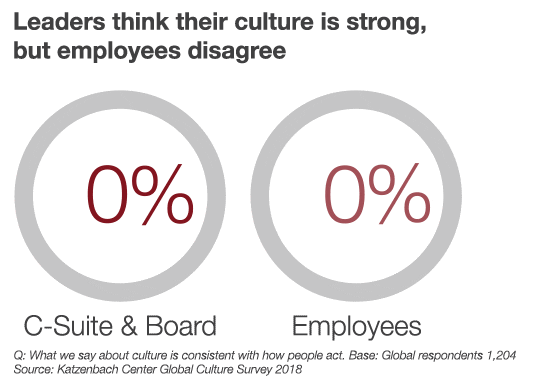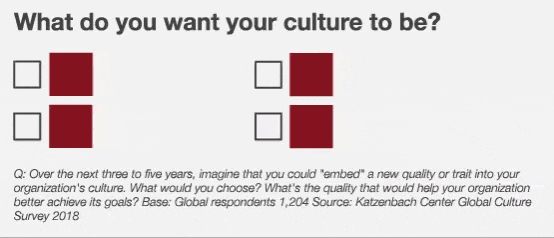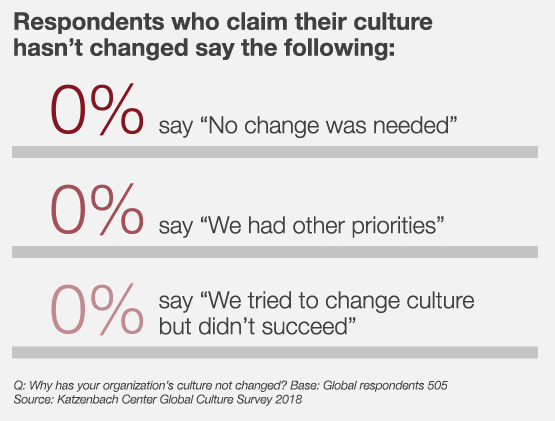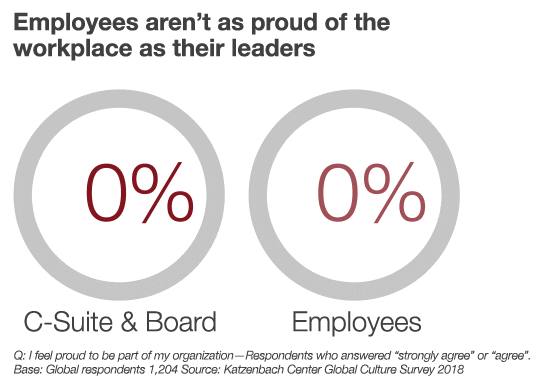
People think culture needs to evolve. Here’s how to make it happen.
Now more than ever, workplace culture can’t go undervalued. In our 2018 survey of more than 2,000 people in 50 countries, one finding stands out: employees feel less positive about their workplace culture than their employers.
It’s an issue that’s urgent and undeniable. A whopping 80% of our respondents say their organization’s culture must evolve in the next five years for their company to succeed, grow, and retain the best people. Backed by decades of research from our global Katzenbach Center, here are five ideas for leaders now.

Five actions to evolve the culture in your organization
1. Address where your culture and your strategy clash

A growing number of C-suite and board members view culture as a critical strategic topic: in fact, 71% say culture is an important topic on their agenda, a notable jump from 64% in 2013. But for the influence of culture to translate into real business results, culture, strategy and operations must be aligned.
Achieving this alignment demands a deep understanding of where your culture is today, and then envisioning its ideal state. Ask yourself: how is the current culture supporting our intentions? What needs to change?
“No culture is all good or all bad. Every culture has emotional energy within it that can be leveraged.”
2. Change your listening tours
There’s a notable difference between how leaders view their culture, and how their people see it. This gap speaks to the perpetual challenge facing
every leadership team: translating high aspirations for culture into day-to-day actions, and bringing others on board.
It takes more than ordinary listening to get a true understanding of the culture at your organization. Instead, challenge and foster healthy debate and real feedback from people across departments and across levels. Connect with people who are emotionally astute and who have insight into what people care about most. These “informal leaders” — employees who may not hold an official leadership role, but who have a ground-level view of the organization’s
cultural reality — can be a powerful force in accelerating behavior changes.

3. Identify the “critical few” behaviors that will shift your culture

Focus first on adopting the few critical behaviors that matter most — tangible actions that, if practiced more often at every level, can help shift the culture. Cultures don’t change quickly, but a disciplined focus on these “critical few” can accelerate and catalyze a purposeful evolution.
As people begin to adopt the behaviors, take time to recognize and reward those people for focusing on those behaviors, too.
4. Step into the "show me" age
Show your people that you’re committed to evolving your organization’s culture by demonstrating the critical few behaviors yourself. This will help make sure the message about culture is received — and believed — by employees. Right now, it isn’t.
Right away, do something that’s visible and concrete. If it succeeds and sends a positive message, repeat it–early and often. Then, encourage others to do the same. When your people see you leading by example, they’re more likely to follow suit.

5. Commit to culture as a continual, collaborative effort

Changing culture is tough, and most efforts fail. Our survey found that 42% of respondents believe that their organization’s culture has remained static for the last five years. That’s not due to lack of effort: 23% of employees report that leaders of their organizations have tried culture change or evolution of some form, but acknowledge that the efforts resulted in no discernible improvements.
Influencing culture is hard, and most leaders declare victory too soon. It can’t be a “one-off” project, nor can it be implemented top-down. Prepare to persevere through obstacles if you want long-term, sustainable change. The more ambitious the effort, the more time and more input from people at all levels it will demand.
Move culture from “Like” to “Love”
“Collaborative.” “Inclusive.” “Open.” Universally, people are far more likely to describe their organization’s culture as positive than negative, even as they see room for improvement.
That positive outlook bodes well for long-term change. People want a culture they can be proud of: our survey found that 72% of C-suite and board members say culture is a strong reason people join their organization. When leaders illustrate a commitment to further evolving their cultures, employees will be more likely to take notice, appreciate the effort, and contribute.


New book
The Critical Few: Energize Your Company’s Culture by Choosing What Really Matters
by Jon Katzenbach
Contact us








